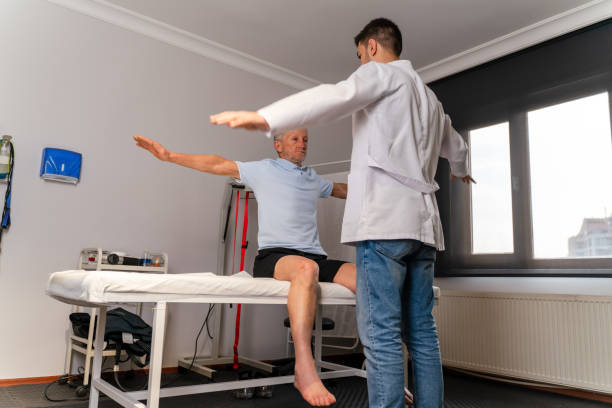Occupational Therapist
Occupational therapy is a health care profession that helps people improve life quality by using everyday activities as treatment.

Occupational therapy is one of the most precious services in healthcare even in the African context although its methods and approaches vary from one region to another one. It is important to realize such things because otherwise it will be difficult to understand how the field of occupational therapy translates into different cultures and societies. In this blog, we will look at the ways occupational therapy is practiced around the world, covering how culture, regional variations, and developed vs developing countries changes occupational therapy.
How is occupational therapy practiced in different cultures?
Occupational therapy practices differ across cultures, with each region incorporating its own customs, values, and beliefs into therapeutic approaches. These differences reflect how societies view health, disability, and rehabilitation.
In some cultures for instance there is family centered care where relatives are very active in the provision of care. There are cultures where it is more focused on being self reliant. For instance in Japan, occupational therapy can be augmented by other ancillary therapies, especially acupuncture; while in the western countries it is more of a clinical discipline. Countries’ colonial histories with particular religions will influence the religion/spirituality requirements by occupational therapists for the patients’ treatment goals and practices.
What are the regional differences in occupational therapy approaches?
Regional differences in occupational therapy approaches are shaped by healthcare systems, available resources, and cultural beliefs. Each region adapts occupational therapy to its unique healthcare and societal needs.
For instance, there is more high-tech rehabilitation equipment emphasis in Western countries like the U.S and Canada, and often customized treatment plans are employed. In contrast, in African and Southeast Asian countries, limited resources are typified by more community-based treatments with therapists working in tandem with the families within a specific geographical region. Furthermore, cultural considerations also determine how treatment is carried out; that is, in Latin American countries, interventions typically integrate treatment to focus on family ties and social interaction as part of the recovery process.

How does occupational therapy vary in developed vs. developing countries?
Occupational therapy in developed countries often involves advanced technologies and personalized treatment plans, while in developing countries, the focus tends to be on community-based rehabilitation and resource allocation.
So, in developed nations such as the U.K or particularly Australia, occupational therapists have modern equipment and proper education and health care. This enables them to do more precise and aggressive therapy. This was not necessarily the case in developing nations where occupational therapy may be taking place in even more rural settings where no such infrastructure even exists. In these cases, however, it is interesting to note, therapists had to think out of the box and make use of inexpensive methodologies to meet the different populations.
How do cultural beliefs influence occupational therapy treatments?
Cultural beliefs shape occupational therapy treatments by influencing patients’ expectations, goals, and the methods therapists use. Each culture brings its own understanding of health and healing to the therapeutic process.
Some cultures have preferred traditional or spiritual healing methods for which an occupational therapist may have to include practices like meditation, herbal remedies or prayer. Other patients may prefer therapy approaches that are in line with their religious or social values. For instance, in countries where a lot of religious practice takes place, spiritual direction could form part of rehabilitation. Occupational therapists, therefore should be aware of these cultures within the societies they operate so as to offer culturally sensitive care by respecting the patients’ belief.

How is occupational therapy education and training different worldwide?
Occupational therapy education and training vary across countries, with differences in accreditation, curriculum, and clinical experience requirements. This diversity influences how therapists are prepared for practice in different regions.
In countries like the U.S, professional level occupational therapist degrees conferred are either a six-year doctor’s program or a three-years master’s program and man clinical practice is done thereafter. In other countries, say parts of Africa or southeast Asia, it will be community based approaches, with the education minimal technology input. Further, there are countries that have provisions for cultural diversity issues as part of their nursing education whereby students are taught on how to meet patients of varied cultural backgrounds. This diversity assures that therapists are well positioned to meet the local healthcare needs.
Conclusion
We can see that in any society and in any particular region, their occupational therapy will always evolve or develop in conformity to the concerns or the culture. These goals already exist – however, the ways of achieving them are different depending on the resources available, the culture and the particular health systems in existence. These differences in the world might not only provide improvements of the occupational therapy practice but also help in appreciating other peoples’ ways of healing and flourishing.
Occupational Therapist
Occupational therapy is a health care profession that helps people improve life quality by using everyday activities as treatment.

Beginning an occupational therapy journey may be daunting, but with the right resources and direction, anyone can begin with confidence. This blog provides beginner-friendly resources and recommendations for new practitioners or curious cases about OT: From educational material to professional associations, understanding the process for getting into OT will help you grow and be successful in this rewarding field. Here are a few common questions that will get you started through the early phases.
What are the basic qualifications needed to start in Occupational Therapy?
The basic qualifications needed to start in Occupational Therapy (OT) is a bachelor’s degree is typically required, followed by a master’s degree in Occupational Therapy. Accredited programs cover anatomy, therapy techniques, and hands-on clinical practice.
It entails undertaking a bachelor’s degree and subsequently, a master’s in OT. Curricula of accredited OT programs feature anatomy, various therapeutic techniques, and the application of these skills to real-life clinical practice. Graduates must also pass a licensing exam to become a certified therapist; for instance, the NBCOT (National Board for Certification in Occupational Therapy). Some states also require licensure, with continuing education, so practitioners are sure to remain aware of the most current practices.
Where can I find beginner resources for learning Occupational Therapy?
Beginner resources for Occupational Therapy can be found through professional associations, online courses, and textbooks. Websites like AOTA and OT Potential offer helpful resources.
A number of fine beginner resources are available to learn occupational therapy. Professional groups such as the American Occupational Therapy Association (AOTA) and websites such as OT Potential offer courses, research papers, and tools specifically designed for new OT practitioners.
In addition, “Willard & Spackman’s Occupational Therapy” may serve as a textbook for foundational reading. Speaking of online courses, Coursera also provides entrance courses focusing on the basics of OT that a student may follow up with to expand their knowledge before acquiring formal education.

How can I gain clinical experience in Occupational Therapy?
Gaining clinical experience in Occupational Therapy involves internships, fieldwork, and volunteer opportunities. Accredited OT programs require supervised clinical hours, providing hands-on experience.
Clinical experience is a core part of becoming a successful Occupational Therapist. Most accredited OT programs require students to complete a number of supervised clinical hours usually through internships or field work placements.
These placements involve students’ working directly with patients under the directives of licensed therapists. Besides formal fieldwork, volunteering at rehabilitation centers or hospitals may be of benefit as well. Performing clinical practice contributes to an OT professional’s building practical skills needed for success in the workplace.
What professional associations should I join as a beginner Occupational Therapist?
Beginner Occupational Therapists should consider joining associations like the American Occupational Therapy Association (AOTA) or the World Federation of Occupational Therapists (WFOT). These groups offer resources, networking, and educational opportunities.
Professional associations, including the American Occupational Therapy Association or the World Federation of Occupational Therapists, should be utilized by early learners. Generally, such organizations provide industry resources, educational materials, and access to networking with other practitioners.
Usually, they have webinars, conferences, or workshops, which make it easy for the new therapists to be updated with the latest trends in the industry. The membership is also helpful for career development and insights into the latest therapeutic techniques and research.
What types of online courses are available for Occupational Therapy beginners?
There are numerous online courses for Occupational Therapy beginners covering topics like anatomy, therapeutic techniques, and patient assessment. Platforms like Coursera and edX offer accredited OT courses.
Online learning platforms like Coursera, edX, and FutureLearn provide courses for people who are newcomers to the profession of Occupational Therapy. Subjects may range from elementary anatomy and physiology up to treatment techniques and client-assessment skills.
These are often courses taught by experienced university professors or professionals from industry, giving that basic knowledge for someone coming into OT. Often, certificates are also provided at the end of the courses. This can add value to a beginner’s resume while applying for an OT program or job.

How do I prepare for the NBCOT exam as a new Occupational Therapist?
To prepare for the NBCOT exam, use study guides, practice exams, and review materials from NBCOT-approved sources. Joining study groups and attending review courses also helps.
Let’s prepare to pass the NBCOT test: focused study and appropriate resources must go hand-in-hand. Begin by using prescribed review texts and practice exams; these will acquaint you with the style of the test and content areas studied.
Most students like to connect with study groups, which sometimes are applicable courses, especially those that can be customized to help you in better preparation for the test. Create a study schedule, and focus much on areas in which you are weak say therapeutic interventions and ethics.
What is the role of continuing education in Occupational Therapy?
Continuing education in Occupational Therapy is essential for staying current on best practices, improving skills, and maintaining licensure. Most states require therapists to complete CEUs.
Continuing education is required to maintain licensure for the occupational therapist in many states. This is to ensure that the therapist remains contemporary about latest treatment techniques, findings from published literature/research, and professional ethics. These can come in the form of workshops, online courses, conferences, or even webinars.
Frequent CE will keep credentials in place for practitioners while, during that same time, improving skills and-a more importantly issue-ensuring care for patients is made better. Besides keeping credentials up, there is also tremendous importance in keeping current with laws of the states and industry standards through CE.
Wrapping Up!
A career in Occupational Therapy begins with education and hands-on experience along with access to the right resources. Membership in professional associations and involvement in the practice of clinical exercises coupled with online learning portals ensure that new entrants in this field adjust well to the preliminary stages of OT practice. Continuing education helps keep the professionals constantly developing in a professional role and, thus, retaining licensure. This guide takes the reader through the process required and recommendations for those preparing to start their journey in Occupational Therapy.
Occupational Therapist
Occupational therapy is a health care profession that helps people improve life quality by using everyday activities as treatment.

Occupational therapists find passion in conducting work where they share their experiences, challenges, and solutions with other practitioners. Joining a community of fellow practitioners improves professional development, letting one grow and learn. Be it a new graduate or an experienced therapist, relating to a patient is always a great thing in care provision.
How can I network with other Occupational Therapists?
Networking with other Occupational Therapists can be done through professional associations, conferences, and social media platforms. Joining OT-specific forums and groups helps connect with peers.
Building relationships is through networking within the Occupational Therapy community. For instance, the American Occupational Therapy Association conferences and workshops are enjoyed by fellow practitioners. Professional associations, local networking events, and online OT-specific forums or groups on LinkedIn expand your network of connections. It is through such avenues that you can collaborate, find a mentor, and advance your career.
What are the benefits of joining an Occupational Therapy association?
Joining an Occupational Therapy association offers access to networking events, continuing education, and industry resources. Associations provide a supportive environment for career growth and professional development.
Organizations such as the AOTA (American Occupational Therapy Association) or WFOT (World Federation of Occupational Therapists) offer several perks. Members get access to network-related events and continuing education, keeping them updated with the latest industry resources.
Another perk offered by these organizations includes advocacy-this keeps you abreast on changes in policies affecting the OT field. Many association memberships come with discounts on conference and certification activities that support long-term professional development.

How can I find a mentor in Occupational Therapy?
To find a mentor in Occupational Therapy, attend conferences, join OT associations, or participate in mentorship programs. Connecting with experienced therapists online can also help you find mentorship opportunities.
Mentorship forms a very important part of professional development in Occupational Therapy. One of the best chances to find a mentor is by attending the conferences and events of OT, with which one can network with experienced therapists.
Many OT associations also have a formal mentorship program that matches new practitioners with experienced professionals, but online forums and social media platforms, including LinkedIn, can also help connect you with potential mentors. A mentor could give you advice on career choices, and help you through challenges in the profession, and also advice on career choices.
What online platforms can I use to connect with Occupational Therapists?
You can connect with Occupational Therapists on LinkedIn, Reddit, and specialized forums like OT potential and AOTA’s online communities. These platforms foster professional discussions and resource sharing.
There are several online forums that enable occupational therapists to connect with one another and interconnect. LinkedIn is an overall career networking website, and the OT groups allow for discussions.
Lots of forums enable people to discuss matters by specialty, and then share resources, case studies, and information about their careers, such as OTpotential, and AOTA’s online communities. OT communities exist on Reddit, allowing more casual-type discussion. In this manner, one is more able to maintain relations and keep updated on what is going on in the field.
How can I contribute to the Occupational Therapy community?
You can contribute to the Occupational Therapy community by sharing knowledge through publications, mentoring younger therapists, and participating in conferences or webinars. Volunteering with OT associations also helps.
Contributing to the OT community beyond just attending events and network opportunities. You can share your experiences by writing articles or case studies for journals or blogs on OT. Mentoring younger therapists to help them find appropriate methods and practices builds the strength of the community.
Volunteering with organizations like AOTA or attending webinars and conferences is an excellent way to give your peers value and insight. Sharing knowledge and supporting others leads to building greater strength in the field while pursuing advance your career.

What are the benefits of joining online OT forums?
Joining online OT forums offers access to professional discussions, resource sharing, and networking with global peers. Forums help Occupational Therapists stay updated on the latest practices.
Online forums on OT potential and AOTA’s platforms can be accessed where one can get involved with a global network of professionals. The forums offer avenues through which therapists can share case studies, research papers, and other resources for practice enhancement.
Members can ask questions, focus on the latest OT techniques, seek advice about specific concerns, and so on. In addition, forums are good avenues for networking and finding a mentor or collaborator. The sum total of experience shared in these settings keeps therapists current with the industry’s growth.
How can I participate in Occupational Therapy conferences?
You can participate in Occupational Therapy conferences by attending in-person or virtual events, presenting papers, or joining workshops. Conference attendance fosters networking and professional growth.
Conferences like the AOTA Annual Conference & Expo are a great place to learn and network with a power network of colleagues. You can attend in person or virtually by registration, listening to selected presentations, workshops, and panel discussions. Presenting your paper or research at a conference may also enhance your professional profile.
These events promote friendships with fellow professionals, expose you to best practices of OT, and help you to gather continuing education credits – all contributing factors to the holistic growth you are to achieve as a professional.
Conclusion
Connecting well with your fellow Occupational Therapists is the best way to engage in personal and professional growth. Networking, mentorship, and online forums are great opportunities through which one can connect with his or her peers, share knowledge, and be updated on the latest practices. By engaging in such OT associations and conferences, one can collaborate meaningfully and move ahead in his or her profession. The guide here will be an essential tool in helping you understand how to establish connections that last forever in the OT field.
Occupational Therapist
Occupational therapy is a health care profession that helps people improve life quality by using everyday activities as treatment.

Occupational therapy professionals enjoy the work since it allows an individual to influence other people’s welfare. Whether providing assistance to an individual to regain his or her independence or working in a rapidly emerging sector of healthcare, which, in turn, creates a professional is no easy task: it requires much effort and the right qualifications. Being on the career advancement ladder of occupational therapy isn’t quite anybody’s cup of tea because it actually resembles occupational and musculoskeletal therapy.
What education is required to become an occupational therapist?
The education required to become an occupational therapist, you must complete a master’s degree in occupational therapy from an accredited program. Afterward, passing the national certification exam is essential for licensure.
The bachelor’s degree in occupational therapy should be from an institution that is properly accredited. Many programs also include more focused courses in anatomy, psychology, and rehabilitation, as well as clinical fieldwork. For licensure purposes, graduating students must also pass the National Board for Certification in Occupational Therapy.
Also, in most states in the U.S, one needs to have a certification in order to practice. Continuing education is also required because the clinician has to keep up with current standards and ways of therapy in their practice with regard to the maintenance of licensure. Entering the profession of OT had to be a combination of studying and including practical experience.
How long does it take to become an occupational therapist?
It takes about six to seven years to become an occupational therapist. This includes completing a bachelor’s degree followed by a two-year master’s program in occupational therapy.
Becoming an occupational therapist typically takes around six to seven years. First, students complete a four-year undergraduate degree, which can be in any major but often includes coursework in biology or health sciences. Afterward, students enter a two-year master’s program in occupational therapy. During this time, they receive both classroom instruction and hands-on clinical experience.
Following graduation, candidates must pass the NBCOT exam to become licensed to practice. While the timeline may vary slightly depending on specific programs or part-time studies, most aspiring occupational therapists can expect to dedicate at least six to seven years to their education and training.

What skills are needed to succeed as an occupational therapist?
The skills that are needed to succeed as an occupational therapist are empathy, problem-solving abilities, and patience. These skills help them work effectively with diverse clients and tailor treatment plans to individual needs.
The occupational therapists who successfully make it in their profession should combine these technical and interpersonal skills. For example, they should be a good communicator explaining the treatment plan or progress to the client and his family. Very often, the clients are struggling with major adversities that are physical or emotional in nature.
Problem-solving abilities make it possible for therapists to work creatively tailored to the needs of each individual, and patience allows them to support clients over a long healing process. Great organizational skills will also be helpful with many cases to track progress with. Mastering these basic skills will ensure occupational therapists find a way to deliver customised care that is not only compassionate but makes a tangible difference to their patients.
What certifications are required to become an occupational therapist?
To become an occupational therapist one must pass the NBCOT certification exam to practice. After certification, maintaining licensure requires ongoing continuing education to stay current with professional standards.
Those who have attained a master’s degree can now sit for the National Board for Certification in Occupational Therapy exam for them to be licensed practitioners. This accreditation is necessary in most states and guarantees that the therapist has complied with the right schooling and code of ethics to be made into a licensed professional.
As a result of completing this accreditation, therapists have themselves obligated to continue their licensure through CEUs refreshed every year that keeps them updated on every new technique and goings-on within the industry. The NBCOT certification is not a one-time process, but rather performed periodically to ensure occupational therapists are providing the best practice.
Can you specialize in a particular area of occupational therapy?
Occupational therapists can specialize in areas like pediatrics, geriatrics, or mental health. Specializing requires additional training or certification in the chosen field.
Specialized therapy enables the therapist to target unique populations or types of treatment and to deliver care that might be better targeted and more successful. For instance, a pediatric occupational therapist may use her expertise in helping children with developmental delays, while an older adult OT would be specializing in ensuring older adults can live independently as long as possible.
Specialization is normally attained with some added certification or even more education in the desired area. The addition of a second specialization in therapy gives the therapist opportunities to further develop their knowledge and therefore offer more holistic services to their patients.

How can you gain practical experience in occupational therapy?
Aspiring occupational therapists gain practical experience through clinical fieldwork, which is a requirement in their academic programs. Internships or volunteer opportunities can also provide valuable hands-on experience.
This is a part of professional training by occupational therapists, which gives such lifeline hands-on experience. Most master’s programs in occupational therapy require students to engage in supervised fieldwork where the theory learned in the classroom is applied in real practice in patient care for several months. This experience helps better train and equip the students with knowledge regarding the daily work of a practicing OT.
Extra experience can be gained through internships or volunteer positions in hospitals, rehabilitation centers, or community health settings. Building these practical skills early helps aspiring occupational therapists to be quite confident and competent when they start their careers.
What is the job outlook for occupational therapists?
The job outlook for occupational therapists is strong, with demand expected to grow by 14% over the next decade. The aging population and increased focus on rehabilitation are driving this demand.
Occupational therapists are likely to be in great demand in the foreseeable future. The growth prospects are said to be 14% for this domain between 2022 and 2032, more than the average rate for all jobs, according to the U.S. Bureau of Labor Statistics. Primarily, this demand will be spurred on by an aging population that will have suffered life-changing events and will need rehabilitative care, and growing acceptance of Occupational Therapy as an approach to recovery of single or multisystem diseases.
Other than clinical settings, Occupational Therapists are increasingly being integrated into school systems, home health care, and outpatient clinics. With such job expectations, there is an evident setting that OT is fast becoming dry and a gratifying choice for career advancement.
In Conclusion
Becoming an occupational therapy practitioner is very rewarding but impossible without strict dedication and education in developing the right skill sets. Since one is done with the master’s program, he or she moves towards gaining practical experience in the field; this is highly challenging but highly rewarding. Coupled with job prospects and plenty of opportunities for specialization, occupational therapy presents a dynamic career with huge potential for making long-term impacts on patients’ lives.
Occupational Therapist
Occupational therapy is a health care profession that helps people improve life quality by using everyday activities as treatment.

Occupational therapy (OT) plays a great role in being able to make someone become independent again and to live a quality life. However, many ask about the cost of investment in OT. Knowing about associated costs enables the patients and their families to choose appropriate healthcare procedures. This article delves into the financial aspect of OT, thereby explaining the therapy costs, insurance, and cost-effectiveness, and tackles myths on the costliness of occupational therapy.
What factors influence the cost of occupational therapy?
The factors that influence the cost of occupational therapy are the duration of treatment, the therapist’s expertise, and the need for specialized equipment. Location also plays a role, with therapy in urban areas often costing more than in rural regions.
Factors that would affect occupational therapy costs include treatment plan duration, the complexity of the case, and the need to use special equipment or facilities. More experienced therapists with excellent qualifications will charge higher prices than less experienced competitors. Geographic location is another issue because therapy in metropolitan areas is relatively costlier because the operational costs are higher.
Some patients might need long-term care or more sessions, resulting in an overall increase in expenses. Knowing all of these factors ensures that patients prepare financially for their journey through therapy.
How much does occupational therapy typically cost per session?
Occupational therapy typically costs between $100 and $200 per session. This varies based on factors such as the therapist’s experience, geographic location, and the complexity of the patient’s needs.
Those therapists with specialized expertise or advanced certifications may also have higher fees. Of course, a bigger factor in fees is the geographic area for which therapy is provided. In more expensive cities, session fees might be at the upper end of this range. More complex patients or those requiring longer sessions may incur higher costs.
Some clinics have a sliding scale fee or even payment plans that might make the therapy more accessible to persons having financial limitations. Many insurance plans have partial coverage for OT costs and reduce some of the costs.

Does insurance cover occupational therapy?
Many insurance plans cover occupational therapy, but coverage depends on the plan and the medical necessity of the treatment. Patients should verify with their provider what is included in their policy.
Most health insurance programs will offer at least partial coverage of occupational therapy if deemed medically necessary by a healthcare provider. However, however, different coverages can exist under different insurance plans. Depending on the coverage, some insurance plans might cover a certain number of sessions per year, while others would require co-payments or deductibles.
While in other instances, it would demand the patient to obtain prior authorization from the insurance before commencing therapy. Patients need to scrutinize what their insurance benefits entail closely and check with their service provider for how much OT is covered under their policy to avoid heaping up unsuspecting expenses.
What are the long-term costs of occupational therapy?
Long-term costs of occupational therapy can accumulate, especially if ongoing treatment is required. Patients should factor in session fees, equipment, and potential insurance limitations for extended care.
Occupational therapy can, in the long run, be very expensive as the services of the therapist might be required continually for chronic conditions or subsequent follow-up after major injuries. Apart from the session fees, the patient may also incur extra costs in the form of specialized equipment that might be necessary, hence raising the cost of treatment.
Even with insurance, there may be restrictions in terms of the number of sessions covered or aspects of the occupational therapy that may be partially covered and which have to be paid out of pocket. Some practitioners offer financing options to help the patient budget longer-term payments; the patient may also need to locate additional resources in the community and therefore begin to plan for and budget on the potential of extended treatment.
How can patients reduce the costs of occupational therapy?
Patients can reduce the costs of occupational therapy by using insurance, seeking sliding scale options, or considering group therapy sessions. Exploring community-based programs can also offer affordable alternatives.
There are various ways patients can contain the expense that goes with occupational therapy. To begin with, maximum insurance benefits are crucial whereby therapy can be covered under the patients’ plan. Many therapists also offer a sliding scale based on income.
Group therapy is always an option, and sometimes it can be a less expensive route than one-on-one sessions. Some community programs or nonprofits may also offer free or low-cost occupational therapy. Finding funds that may be available through local or state money can be helpful in terms of long-term care.

Is occupational therapy worth the financial investment?
Occupational therapy is worth the financial investment for many, as it helps improve independence and quality of life. The long-term benefits often outweigh the initial costs, especially for patients with chronic conditions or injuries.
The advantage of therapy is a capacity that will make it possible to execute activities in daily practice that otherwise would be impossible and not rely on others. Of course, although the costs are initially high, the benefits include enhanced well-being and functional abilities, which can be much higher than their expenses in the long run. Moreover, many patients achieve improved mental health as an aftereffect of the enhanced independence brought through therapy.
Are there financial assistance options for occupational therapy?
Financial assistance options for occupational therapy include government programs, nonprofit organizations, and insurance subsidies. Patients can explore these resources to reduce their out-of-pocket expenses.
Several options in terms of financial assistance are available for patients who have specific concerns regarding the costs of this treatment. Government programs, such as Medicaid, for example, may also allow for OT coverage amongst underprivileged or disabled people. Nonprofit organizations are also providing grants or reduced costs for eligible patients.
Other insurance companies offer some subsidies or special programs to extend OT services. Alternatively, the patient can negotiate a payment plan or sliding fee scale with a therapist. All these approaches significantly minimize out-of-pocket expenses and often create an entry point in OT for patients who have to visit therapy for a long time or frequently.
Wrapping Up!
Therefore, it is crucial that patients and families be educated on the financial investment into occupational therapy. Of course, the cost of treatments will vary greatly with many factors such as the duration of each session, insurance coverage, and location, but overall benefits usually make long-term investments worthwhile in OT. Patients can also look into other alternative funding options that can reduce their burden and, therefore, find this treatment more affordable. Ultimately, however, the improved quality of life offered by OT is such a high-value investment for many.
Occupational Therapist
Occupational therapy is a health care profession that helps people improve life quality by using everyday activities as treatment.

Occupational therapy has been a crucial part of health care services, but like everything else, this profession suffers through criticism and controversy. Most critics contend it is less effective, costly, and not so useful overall.
In this paper, we discuss the challenges posed by occupational therapy and what it offers in response. Shining a light on these concerns will give a balanced view to enlighten the importance and the effectiveness of OT in helping patients lead a better quality of life.
What are the main criticisms of occupational therapy?
The main criticism of occupational therapy is that it often highlights concerns about measurable outcomes, particularly in severe cases. They argue that results can be unclear and inconsistent, leading to doubts about its overall effectiveness and cost.
Apart from this, some critics feel that occupational therapy is more intangible compared to other medical treatments. Successes in a patient’s life- such as independent living or mental well-being-are often dependent upon interpretations such as “the patient is now able to.” and do not become apparent until a long time has passed.
For example, critics feel that the therapy may be expensive, even lengthy, and, during such lengthy therapy, the patient can’t find direct benefits. Although there are those challenges, advocates of OT highlight the necessity of individualized care planning with a long-term approach to every patient’s progression. Treatment approaches fall under an ever-changing trend as advancement in them concerns OT professionals.
Why is occupational therapy considered expensive by some?
Occupational therapy is considered expensive due to its long-term treatment plans, which often involve recurring sessions. Specialized equipment and the personalized nature of the care also contribute to the overall cost of the therapy.
Occupational therapy can be cumulative in cost, especially over treatment periods that are extended. The reasons for the cost to be driven so high are frequent sessions, requirements of specialized equipment, and treatment plans that are individualized. Critics argue that not all patients will see benefits from the therapy at the same instant.
They have thus questioned the value for money. On the other hand, the therapists argue that often long-term benefits compare to the short-term costs as long as it has improved the quality of the life of a patient. Furthermore, most insurance plans offer partial or total coverage for the cost of occupational therapy services where a person needs it.

How does occupational therapy address its effectiveness concerns?
Occupational therapy addresses effectiveness concerns by using evidence-based practices tailored to individual patient needs. Therapists track progress through measurable goals and adapt treatment plans to ensure continuous improvement.
There is an evidence-based approach to occupational therapy where treatment plans are tailored to individual patient needs, thereby addressing the effectiveness of treatment. Therapists work in collaboration with clients to formulate clear, measurable goals concerning improved mobility, cognitive skills, and everyday activities.
Progress is routinely monitored and appropriately adjusted in interventions to ensure optimal results. Critic, on the other hand, argues that the gains, such as mental well-being or independence, are subjective and hard to quantify. With an emphasis on individual progress, professionals who work for OT make efforts to prove that the impact of the therapy stays long after it was administered.
What challenges do occupational therapists face in proving outcomes?
Proving outcomes in occupational therapy is challenging because progress can be gradual and subjective. While therapists set measurable goals, patient improvements like independence or well-being are harder to quantify.
One of the major challenges that comes before occupational therapists is the subjective nature of progress. Even though therapists set measurable goals for their patients, like improvements in motor skills or about the capacity to do daily activities, improvement like mental well-being or social interaction are not easy to measure.
Furthermore, a long-term activity, occupational therapist can be viewed as ineffective in the short run with noticeable changes only in the long run. Therapists make progress in recording it through regular assessments and adaptations in the treatment plan. Through such improvement overtime, occupational therapy shows its worth even though the changes cannot be seen immediately.
Why is occupational therapy often misunderstood?
Occupational therapy is often misunderstood because many people think it only addresses physical rehabilitation. However, OT helps with a wide range of issues, including mental health, cognitive challenges, and daily living skills.
Many people misunderstand occupational therapy as being only rehabilitation, such as the remediation of patients who have injuries or surgery. However, what people often forget is that occupational therapy has far greater scope: mental health support, cognitive functioning advancement, and engaging patients in a routine approach to daily living skills. These misconceptions lead to confusion over the therapy’s true purpose and application.
Occupational therapists work with all ages, from a developmental delay in a child to a chronic condition in an adult, and work so often with so many other issues beyond any form of physical recovery. To overcome these misconceptions, public education about the wide-ranging benefits of OT is paramount.

What are the common misconceptions about occupational therapy?
Common misconceptions about occupational therapy include the belief that it’s only for physical rehabilitation and that it’s not as effective as other therapies like physical therapy. However, the occupational therapist addresses mental, emotional, and physical challenges.
Many misconceptions surround occupational therapy. It is actually considered helpful in rehabilitating the body. In fact, occupational therapists can help overcome various difficulties which might be psychological or cognitive, and help persons to regain independence in day-to-day activities. The other misconception is that it is not as effective compared to physical therapy; however, occupational therapy complements physical therapist with an independent setting of recovery.
In addition, occupational therapy is not only rehabilitating injury but also assisting people with mental health issues and developmental conditions. These myths are maintained because of ignorance, and increasing public enlightenment will generally clarify the actual place of occupational therapy within health care.
How does occupational therapy respond to its critics?
Occupational therapy responds to critics by focusing on personalized care, evidence-based practices, and long-term patient outcomes. The therapy’s adaptability ensures it remains relevant to patients’ evolving needs.
Occupational therapy counteracts its detractors inasmuch as it focuses on its patient-centered approach and evidence-based practice. Treatment plans are tailored based on the specific needs of a patient, which enables therapy to be flexible enough for most conditions.
Despite this, some critics claim that Occupational therapy does not lead to prompt, observable measurable outcomes, yet the profession has time for long-term outcomes like increased independence, mental recovery from several disorders, or enhancing everyday skills to live with practical abilities for everyday chores.
Scientific evidence goes as far as the long-term changes, which can prove that by exposing an individual to occupational therapy, there is substantial change over a period of time in a person. In this way, by continuously updating their knowledge and inclusion of new knowledge, Occupational therapy professionals ensure that the treatment taken by the patients will be applicable and relevant to the patient’s needs.
In Conclusion
Occupational therapy, like any profession, has its controversies and criticisms. However, it is indispensable in health care and can never be removed. Even when the profession grapples with the challenges of proving outcomes and dispelling misconceptions against them, evidence-based practice and patient-centered care will continue to do well for Occupational therapy. Long-term improvements that help individuals lead to independence and quality of life owe themselves to therapists. Further growth in the open dialogue and research will give ample assurance to the presence and effectiveness of OT in the future.
Occupational Therapist
Occupational therapy is a health care profession that helps people improve life quality by using everyday activities as treatment.

Well, most people who come to learn about occupational therapy quickly link it to rehabilitation. This is indeed true, but occupational therapy can impact one’s personal growth in so many more wonderful ways. It focuses on improving life skills, emotional well-being, and confidence occupational therapy can indeed be a life-changing profession.
This blog aims to find how occupational therapy contributes to long-term personal development and growth by illustrating key areas such as emotional resilience, self-confidence, and everyday living practical skills which are all the core aspects of day-to-day living.
How does occupational therapy contribute to personal growth?
Occupational therapy contributes to personal growth by helping individuals enhance their physical, emotional, and cognitive abilities. It focuses on empowering people to lead more fulfilling and independent lives.
Occupational therapists collaborate with their patients to set personally tailored goals toward daily task challenges, social interaction challenges, and emotional regulation difficulties. This leads, through physical exercises, cognitive strategies, and even emotional support within occupational therapy, to resilience, flexibility, and problem-solving capacity enabling persons to grow by better managing their lives to overcome their limitations and unlock their potential in achieving more and contributing towards personal growth and fulfillment.
Can occupational therapy improve emotional well-being?
Occupational therapy improves emotional well-being by teaching coping strategies, enhancing self-awareness, and encouraging participation in meaningful activities. It helps individuals better manage stress and emotional challenges.
Occupational therapists commonly employ mindfulness techniques, stress-relieving exercises, and therapeutic activities for dealing with emotional issues such as anxiety or depression. Positive engagement in daily routines and meaningful hobbies help patients acquire a much better sense of purpose and emotional balance. Over time, these strategies can reduce adverse emotions, enhance emotional regulation, and generally lead to better mental health, making it a very promising tool for personal emotional development.

What role does occupational therapy play in building self-confidence?
Occupational therapy helps build self-confidence by enabling individuals to achieve personal milestones and regain independence in daily tasks. Successfully completing therapy goals boosts confidence and self-esteem.
Occupational therapists set reachable goals. The patients can track their progress over time. Improvement in motor skills, cognitive functions, or social abilities gives patients a sense of accomplishment. No matter how slight these achievements may seem, they enforce the belief that they can overcome challenges. Gradually increasing the difficulty in these tasks and with positive feedback led individuals to their self-confidence and perseverance with future challenges.
How does occupational therapy help individuals develop life skills?
Occupational therapy helps individuals develop life skills by providing practical training in areas like self-care, time management, and social interaction. It equips patients with the tools to handle everyday responsibilities.
Occupational therapists work on basic and advanced life skills in grooming, cooking, managing schedules, and the like. In the event of recovery from injuries or disabilities, all of these would be awkward if not learned.
Therapists use adaptive equipment and adapt individualized interventions to make the patient independent regarding the same. Besides, therapy in terms of social communication thus improves relationships at the workplace and personal lives and thus improves quality of life.
Can occupational therapy support long-term personal development?
Occupational therapy supports long-term personal development by promoting sustainable habits, adaptive techniques, and continuous self-improvement. It encourages lifelong learning and growth beyond therapy sessions.
The skills learned in occupational therapy are applied directly and immediately into daily life outside the clinic walls. Clinics teach patients on how to apply what they have learned in daily living.
It supports further personal development outside the confines of occupational therapy sessions. Whether it is stress management, physical health maintenance, or continued cognitive improvement, adaptive skills learned in occupational therapy ensure one never stops improving with time. This continuous growth aspect of occupational therapy makes a system meant for life transformations-a last resort tool for personal change.
Conclusion
Occupational therapy is not only about rehabilitating the body, but it represents the process of developing a person, increasing self-confidence to new heights, and other positive life skills. Targeting emotional well-being and independence for long-term growth, occupational therapy empowers people to lead richer, more balanced lives. Personalized goals and practical strategies shape occupational therapy into the tool by which people can fundamentally change the way they see challenges and tackle life.
Occupational Therapist
Occupational therapy is a health care profession that helps people improve life quality by using everyday activities as treatment.

Home-based occupational therapy for a patient to follow the rehabilitation or treatment at a comfortable, familiar place. Making an environment that is conducive to healing will provide a sense of relaxation and concentration, and thereby enhance the effectiveness of the treatment in the first place. In this blog post, we will describe how to create an environment for home-based occupational therapy, the important tools for treatment, support from caregivers, exercises that should be tried, and how to modify one’s home for the best therapeutic results.
How can I create a healing environment for occupational therapy at home?
Creating a healing environment for occupational therapy at home involves organizing a quiet, comfortable space free from distractions. The area should promote focus, safety, and ease of movement.
Appropriate lighting, enough space for exercise, and free from tripping hazards are among the factors that make a chosen space suitable. It is also possible to create a lessening stress environment using elements such as soft music or plants, soothing colors, and so on. The environment may also be adapted according to the patient’s needs, like adaptive furniture and tools for mobilization. This particular space can also be used regularly for therapy to promote better mental and physical improvement.
What are essential tools for practicing occupational therapy at home?
Essential tools for practicing occupational therapy at home include therapy balls, resistance bands, hand-strengthening equipment, and adaptive devices. These tools help patients engage in targeted exercises to improve motor skills.
Selecting such is on the demand of the patient. Therapy balls, resistance bands, or hand-strengthening tools, like putty or grip trainers, are used for strength and flexibility training. Adaptive devices, such as grab bars, a raised toilet seat, or walker, allow safe independence and can be necessary for mobility-challenged patients. All these available tools make it easy to reproduce the therapy sessions in the comfort of one’s home and attend to every patient’s different rehabilitation needs.

How can caregivers support home-based occupational therapy?
Caregivers can support home-based occupational therapy by assisting with exercises, encouraging independence, and maintaining a consistent routine. Their involvement can help the patient stay motivated and on track with therapy goals.
The occupational therapist should be updated closely so that they understand the set of exercises to be done in treatment. They can guide proper application and make sure the person in need is safe when doing those exercises at home. Emotional support and encouragement are also important, as recovery can be tough to bear. Caregivers also can help organize space for therapy so that equipment and tools can always be available in case of each session, which aids progress observation overtime.
What exercises can be done at home for occupational therapy?
Occupational therapy exercises that can be done at home include range-of-motion exercises, strengthening drills, and cognitive tasks. These exercises focus on improving daily functional abilities.
Flexibility exercises, like shoulder stretches or rotation of the wrists, help improve flexibility, especially in patients who have undergone surgery or have other injuries. Strengthening exercises include resistance band exercises or using small weights to increase muscle tone and coordination.
Cognitive exercises, like crosswords or games that test memory, lead cognitively impaired patients toward focus and problem-solving capacities. In this way, these exercises can be performed every day outside the clinic, yet within set parameters and evolving a patient’s ability to reach their therapy goals even better than during the session.

How can I adapt my home for occupational therapy activities?
Adapting your home for occupational therapy activities involves making adjustments to ensure safety and accessibility. Modifications might include installing grab bars, rearranging furniture, or using adaptive tools for daily tasks.
Safety modifications, like the removal of rugs, addition of non-slip mats, ensuring walkways are obstruction-free, may eliminate accidents. Grab bars and handrails help improve patients’ balance in the bathroom or up and down the stairs. Also, some adaptive equipment, which may be a reaching device or a modified kitchen utensil, can assist patients with low mobility to perform self-care independently. Such adaptations enable patients to carry out exercises in occupational therapy and make them a part of daily life, so assisting them to return to independent lives.
Conclusion
Home-based occupational therapy enables patients to continue to be effectively treated in a safe and familiar environment. Creating a healing environment, utilizing necessary equipment, and preparing the home for safety enhances the effectiveness of the treatment since patients are able to carry out the exercise continuously with the support of family members and caregivers and an individualized exercise plan to lead towards sustained progress, improved daily activities, and long-term rehabilitation.
Occupational Therapist
Occupational therapy is a health care profession that helps people improve life quality by using everyday activities as treatment.

Occupational therapy is one of the effective therapies which can be used to change or to enhance the use of particular skills in any individual. Every treatment procedure has its benefits and accompanying risks and so is the case with occupational therapy. As a matter of fact, patients can only have a safer and more effective professional experience if they are well aware of the risks involved and take the appropriate measures. In this blog, risk factors are outlined, risk control measures are described, and ways to prevent undesirable outcomes are presented.
What are the potential risks of occupational therapy?
The potential risks of occupational therapy include physical strain, fatigue, and emotional discomfort. Some patients may experience temporary discomfort as they adapt to new therapeutic exercises and routines.
Relatively, occupational therapy involves assignments and tasks that begin to test an individual’s limits, first emotionally and later physically. During motor skills practice, the feeling of soreness may occur due to muscle fatigue exerted in training. The same applies to emotional fatigue management during therapy. Injuries most often result from an incorrect approach or from an unmonitored population. Occupational Therapists are still scrutinizing the population so that the occurrence of such events is less and exercises are not performed as required.
Can occupational therapy cause physical discomfort?
Occupational therapy can cause physical discomfort, especially when patients are working to regain strength or mobility. Muscle soreness and fatigue are common as patients push their physical limits.
Exercises for therapeutic purposes often push muscles, joints, and tendons to the limit, especially in patients recovering from injuries or surgeries. Though it is usually mild and temporary, this is often frustrating to the patients. The therapists observe the degree of exercises so that there is no over-working the patient, and they teach the patients how to manage pain, including rest and ice application. Open communication with the therapist will also help ensure that the patient stays in a safe range of discomfort.

Are there any psychological side effects in occupational therapy?
Occupational therapy can have psychological side effects, such as emotional distress or frustration, especially for patients dealing with trauma or cognitive impairments. The therapist may bring up difficult emotions during sessions.
While trying to treat a patient, it is possible to encounter mental or emotional barriers that may provoke stress or anxiety to the patient. Trauma patients suffering from head injury may find such exercises to be egregious. In addition, certain emotions can be elicited in the course of treatment which is usually geared towards certain types of patients with such disorders as PTSD, and anxiety among many others. In spite of this, the occupational therapists are rather good in containing bald solutions and emotional swelling of the patients informing them that this will all subside in the act of therapy.
What precautions should be taken before starting occupational therapy?
Precautions before starting occupational therapy include consulting with a healthcare provider, understanding any medical restrictions, and communicating with the therapist about your specific health concerns.
It is indeed crucial that patients be assessed prior to beginning occupational therapy, and all questions relevant to their pre-existing conditions, surgeries, or medications should be discussed. The patients must also consult their therapist as to what would be exercised in the therapy, how they should prepare, and what to expect during every session. This allows therapy to be oriented towards the needs of the patient while preventing health risks and exacerbation of the condition.

How can patients minimize side effects in occupational therapy?
Patients can minimize side effects in occupational therapy by following therapist instructions, resting between sessions, and communicating openly about any discomfort. Regular feedback helps the therapist adjust the treatment plan.
After getting the treatment, the patients who participated in the therapy stood a better chance of getting better if they followed the exercises assigned and did not hide anything about their feelings towards the treatment regime.
It is quite important to rest as too much exertion may result in strain on the muscle or a breakdown in terms of emotion. The need to hydrate, supportive clothes, and activity level during exercise is also beneficial. Owing to the fact that these exercises may pose certain risks to the patient, thermometer management will enable the patient and intensive therapy to reach optimum precaution by determining the treatment that, at the moment, is safe and meets the purpose.
Final thoughts
Occupational therapy has its share of advantages but as they say, risk is part of the game and so with proper prevention measures in place, one can avoid risk. A satisfactory fantastic thorough odontological treatment demands that the patient should adhere to certain pre-and post-treatment measures in order to enjoy the benefits to the fullest while reducing complications: in this case, you should inform your healthcare providers, abide by the directives of the therapeutic services, and appreciate the adverse effects that may arise.
Occupational Therapist
Occupational therapy is a health care profession that helps people improve life quality by using everyday activities as treatment.

Occupational therapy is the process of gaining independence in daily activities, with an improvement in both physical, emotional, and cognitive functions. Occupational therapy guides patients toward living a fulfilling life. In this blog, we will look at how occupational therapy leads to enhancement in well-being through expert tips and techniques, along with ways that families can help their loved ones in this journey.
How can occupational therapy improve daily functioning?
Occupational therapy improves daily functioning by helping individuals develop skills needed for personal care, work, and leisure activities. Therapists focus on enhancing physical and cognitive abilities to regain independence.
More specifically, occupational therapists evaluate every patient’s needs, making an individualized treatment plan for him. Since motor skills, coordination, and cognitive exercises improve the ability to dress independently, cook, and drive, people become even more self-sufficient.
Adaptive equipment is also introduced by the therapists if it is determined that their clients need it in order to greatly enhance their abilities further in handling daily activities. With time, these interventions also have a tremendous impact on increasing the quality of the individual’s life and independence.
What are the key techniques used in occupational therapy?
Occupational therapy utilizes techniques such as motor skills training, cognitive exercises, and adaptive strategies. These approaches are customized based on the patient’s needs to restore or enhance their daily abilities.
A closer look will indicate that many therapists do task-oriented exercises that mimic real-life experience. For example, hand injury patients can be helped with their dexterity with pinch exercises of small objects. Cognitive strategies may involve memory training or problem-solving exercises in cases of strokes. Therapists can also provide recommendations for home modification, helping make living environments safer and easier to navigate, thereby facilitating smoother day-to-day functioning.

How does occupational therapy support mental health?
Occupational therapy supports mental health by promoting emotional well-being and coping strategies through meaningful activities. It helps individuals build routines and regain control over their lives.
This means that occupational therapists take depressed, anxious, or PTSD patients and engage them in meaningful activities that make them have a feeling of competence. With this, the therapist enables his or her client to build wholesome habits that reduce stress levels and enhance clear mental operation. This can also relate to mindfulness practice, relaxation skills, and social participation in building a strong emotional resilience and recovery of mental health.
What role does goal-setting play in occupational therapy?
Goal-setting in occupational therapy is essential for tracking progress and motivating patients. It helps both the therapist and the patient focus on clear, achievable objectives during recovery.
The cooperation between the therapist and patient establishes goals which encompass immediate and long-term targets. The spectrum could range from coordination of fine movements to return to work. Patients become much motivated once they feel that steady progress is being realized in achieving smaller goals into manageable and ordered steps. Continuous evaluation of the set goals ensures that the conducted therapy finds its congruence with the ever-changing needs of the patient, thus guaranteeing a positive result of the therapy.

How can families support occupational therapy for loved ones?
Families can support occupational therapy by creating a supportive environment, encouraging independence, and assisting with exercises at home. Active involvement improves therapy outcomes.
Families are beneficial in consolidation of the therapy process outside the clinical area. From learning the techniques and exercises from the therapist, each member of the family can act as an implementer of the same techniques and exercises at home; thus, care continues to be observed. By making the patient self-dependent while still assisting as required ensures that the patient increases his self-confidence. Besides, open communication between the therapist and the family allows adjusting the therapy session as the patient progresses; thus, full support is experienced throughout the process.
Conclusion
Occupational therapy plays a crucial role in helping patients regain their independence and quality of life. Personalized techniques, goal setting, and family involvement all help to maximize healing potential, and thus maintain or regain aspects of mental, physical, or emotional well-being. Understanding occupational therapy will empower a patient and his family to participate in the healing process.
